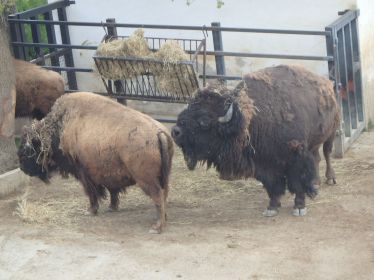- Marsupials (Diprotodontia)
- Carnivorous marsupials (Dasyuromorphia)
- Tenrec (Afrosoricida)
- Elephant shrew (Macroscelidea)
- Elephant (Proboscidea)
- Sea cows (Sirenia)
- Armadillos (Cingulata)
- Edentata (Pilosa)
- Treeshrew (Scandentia)
- Primate (Primates)
- Rodent (Rodentia)
- Bats (Chiroptera)
-
Even-toed ungulate (Artiodactyla)
-
Bovidae
- Addax (Addax nasomaculatus)
-
American bison (Bison bison)
- Barbary sheep (Ammotragus lervia)
- Blue duiker (Philantomba monticola)
- Kirk's dik-dik (Madoqua kirkii)
- Lechwe (Kobus leche)
- Lowland anoa (Bubalus depressicornis)
- Muskox (Ovibos moschatus)
- Sable antelope (Hippotragus niger)
- Sitatunga (Tragelaphus spekii)
- Aberdeen Angus
- Danish Landrace goat
- West African Dwarf goat
- Cervidae
- Camelidae
- Giraffidae
- Hippopotamidae
- Suidae
-
Bovidae
- Odd-toed ungulate (Perissodactyla)
- Carnivores (Carnivora)
American bison (Bison bison)

The American bison (Bison bison; pl: bison), also called the American buffalo or simply buffalo (not to be confused with true buffalo), is a species of bison native to North America. It is one of two extant species of bison, alongside the European bison. Its historical range, by 9000 BCE, is described as the great bison belt, a tract of rich grassland that ran from Alaska to the Gulf of Mexico, east to the Atlantic Seaboard (nearly to the Atlantic tidewater in some areas), as far north as New York, south to Georgia, and according to some sources, further south to Florida, with sightings in North Carolina near Buffalo Ford on the Catawba River as late as 1750. Once roaming in vast herds, the species nearly became extinct by a combination of commercial hunting and slaughter in the 19th century and introduction of bovine diseases from domestic cattle. With a population of 60 million in the late 18th century, the species was culled down to just 541 animals by 1889 as part of the subjugation of the Native Americans, because the American bison was a major resource for their traditional way of life (food source, hides for clothing and shelter, and horns and bones for tools). Recovery efforts expanded in the mid-20th century, with a resurgence to roughly 31,000 wild bison as of March 2019. For many years, the population was primarily found in a few national parks and reserves. Through multiple reintroductions, the species now freely roams wild in several regions in the United States, Canada, and Mexico, with it also being introduced to Yakutia in Russia. Spanning back millennia, Native American tribes have had cultural and spiritual connections to the American bison. It is the national mammal of the United States of America.
In Aquariums and Zoos: rare in Europe (Most zoo's in Europe have the plains bison)
In Aquariums and Zoos: rare in Europe (Most zoo's in Europe have the plains bison)
woaqzo@yahoo.com